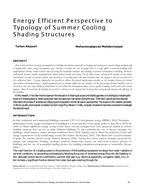Due to forty presents of energy consumption on building construction especially on heating and cooling part, passive design methods help to significantly reduce energy consumption rate. Therefore to reduce the vast of energy, there is a large effort to construct building with inappropriate thermal comfort which cause by using the unsuitable windows and shading or incorrect orientation of building. Moreover undesirable thermal comfort inappropriately affects human health and living. On the other hand, enhancing the quality of the indoor environment in order to provide comfort and convenience is receiving more and more attention from the designers and the researchers in the architecture field. Various approaches are possible to achieve the desired improvement window, as the interface between the indoor and outdoor environment plays a highly important role in creating comfort for the residents. In the good design thermal comfort is one of the factors that can create feeling of satisfaction in users from the environment reduce stress, regulate sleeping, habits and ensure better hygiene. Also, the heat from the sunlight can result in a decrease in the need for heat by fossil fuels and generally increases the efficiency of the building.
In this research, it has been tried to ascertain the interaction of shading structures and shading geometry in building (by indicating the function of shading device in receiving day light heat and gaining or losing heat during the day). Afterward, according to the obtained information the process of architectural designing and computation of thermal load is accomplished. The studies in this research are based on library studies and computer simulation by the Energy Plus software. Finally, computer simulations have been conducted to investigate the obtained result.
Citation: Second International Conference on Energy and Indoor Environment for Hot Climates, Doha, Qatar, February 2017
Product Details
- Published:
- 2017
- Number of Pages:
- 8
- Units of Measure:
- Dual
- File Size:
- 1 file , 2.3 MB
- Product Code(s):
- D-HCC17-05
